Effective Business Communication: Fundamentals and Impact on Internal Communication in Organizations
VerifiedAdded on 2023/06/05
|8
|2296
|95
AI Summary
This essay discusses the importance of effective business communication and its impact on internal communication in organizations. It also highlights significant topics learnt in the course such as cross-cultural communication and communication within teams and groups, and their relevance to future career aspirations.
Contribute Materials
Your contribution can guide someone’s learning journey. Share your
documents today.
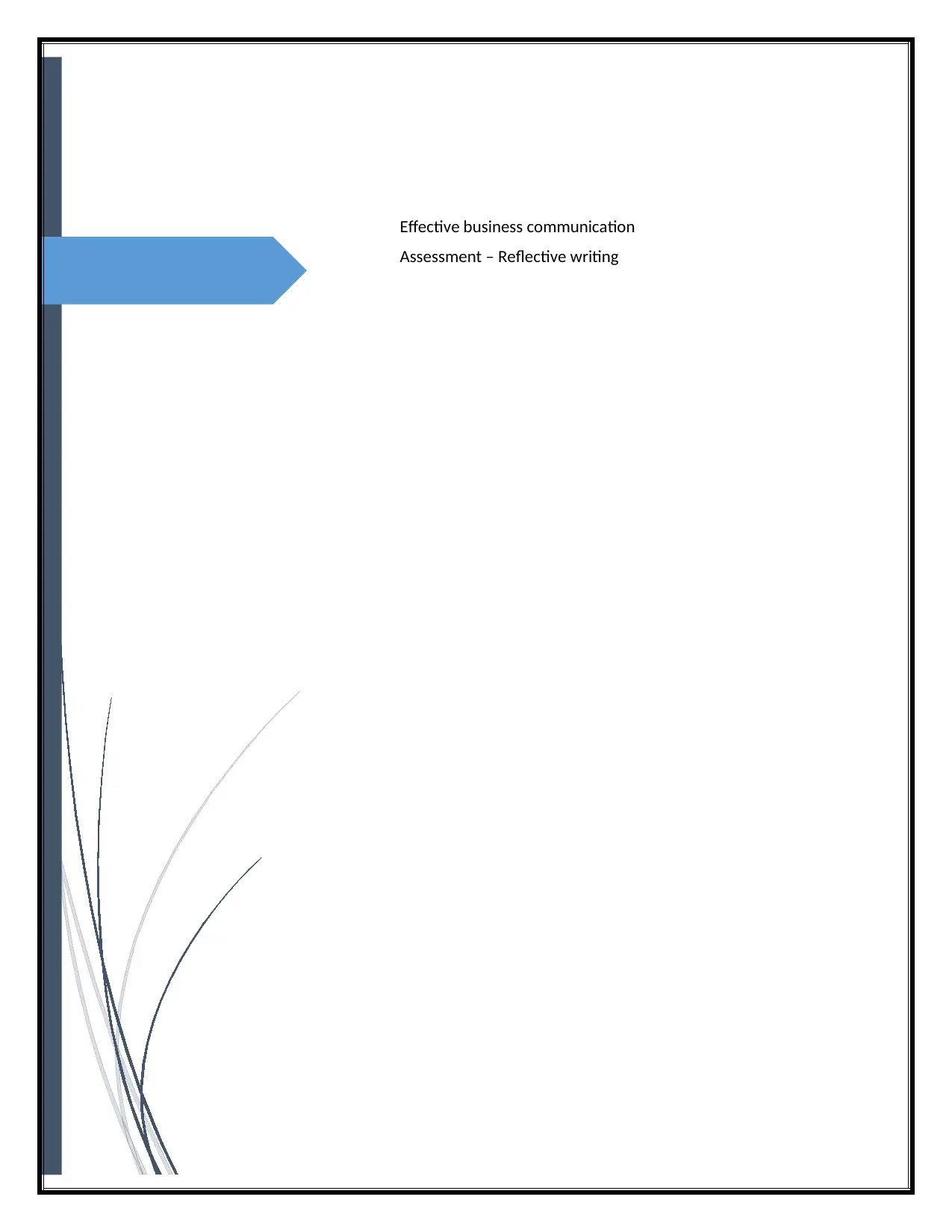
Effective business communication
Assessment – Reflective writing
Assessment – Reflective writing
Secure Best Marks with AI Grader
Need help grading? Try our AI Grader for instant feedback on your assignments.
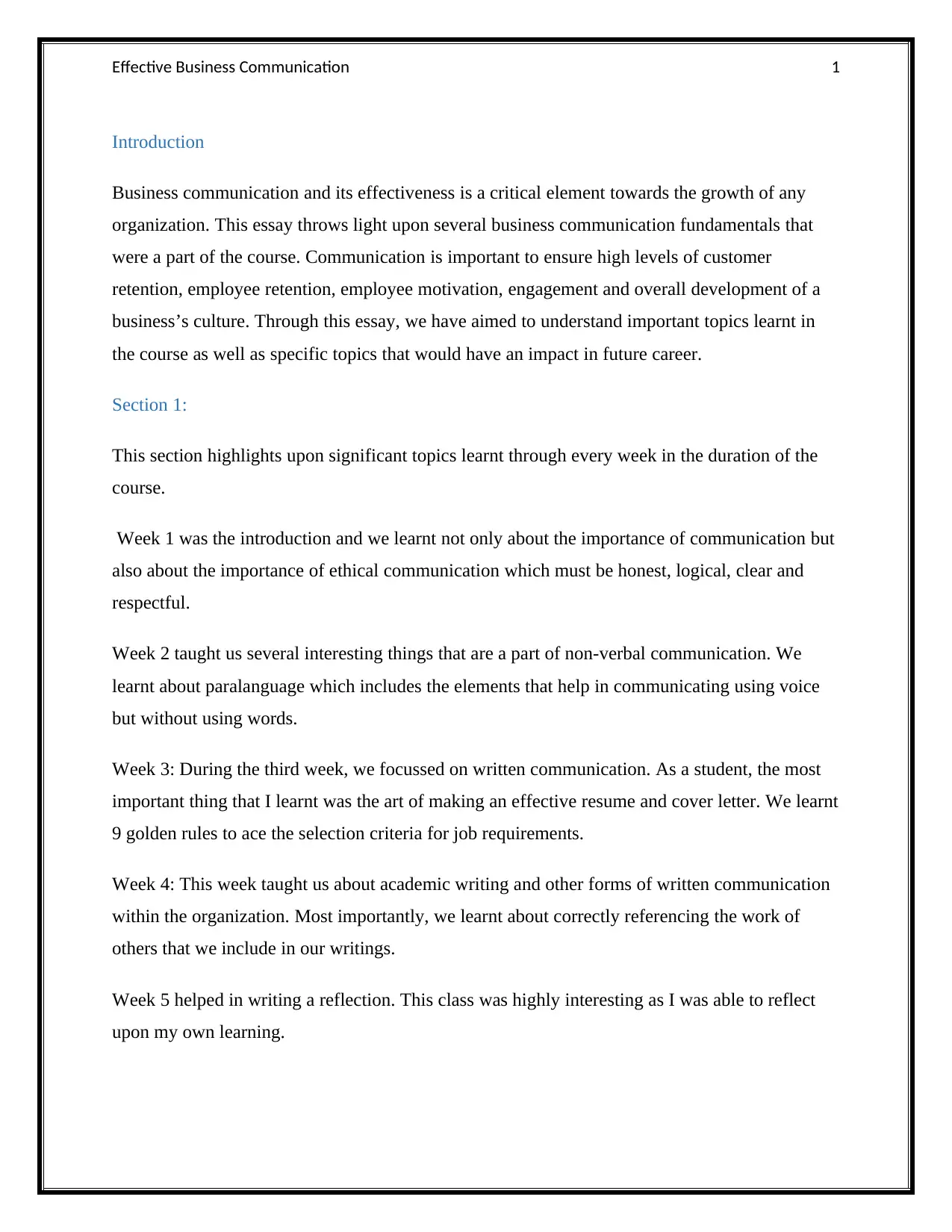
Effective Business Communication 1
Introduction
Business communication and its effectiveness is a critical element towards the growth of any
organization. This essay throws light upon several business communication fundamentals that
were a part of the course. Communication is important to ensure high levels of customer
retention, employee retention, employee motivation, engagement and overall development of a
business’s culture. Through this essay, we have aimed to understand important topics learnt in
the course as well as specific topics that would have an impact in future career.
Section 1:
This section highlights upon significant topics learnt through every week in the duration of the
course.
Week 1 was the introduction and we learnt not only about the importance of communication but
also about the importance of ethical communication which must be honest, logical, clear and
respectful.
Week 2 taught us several interesting things that are a part of non-verbal communication. We
learnt about paralanguage which includes the elements that help in communicating using voice
but without using words.
Week 3: During the third week, we focussed on written communication. As a student, the most
important thing that I learnt was the art of making an effective resume and cover letter. We learnt
9 golden rules to ace the selection criteria for job requirements.
Week 4: This week taught us about academic writing and other forms of written communication
within the organization. Most importantly, we learnt about correctly referencing the work of
others that we include in our writings.
Week 5 helped in writing a reflection. This class was highly interesting as I was able to reflect
upon my own learning.
Introduction
Business communication and its effectiveness is a critical element towards the growth of any
organization. This essay throws light upon several business communication fundamentals that
were a part of the course. Communication is important to ensure high levels of customer
retention, employee retention, employee motivation, engagement and overall development of a
business’s culture. Through this essay, we have aimed to understand important topics learnt in
the course as well as specific topics that would have an impact in future career.
Section 1:
This section highlights upon significant topics learnt through every week in the duration of the
course.
Week 1 was the introduction and we learnt not only about the importance of communication but
also about the importance of ethical communication which must be honest, logical, clear and
respectful.
Week 2 taught us several interesting things that are a part of non-verbal communication. We
learnt about paralanguage which includes the elements that help in communicating using voice
but without using words.
Week 3: During the third week, we focussed on written communication. As a student, the most
important thing that I learnt was the art of making an effective resume and cover letter. We learnt
9 golden rules to ace the selection criteria for job requirements.
Week 4: This week taught us about academic writing and other forms of written communication
within the organization. Most importantly, we learnt about correctly referencing the work of
others that we include in our writings.
Week 5 helped in writing a reflection. This class was highly interesting as I was able to reflect
upon my own learning.
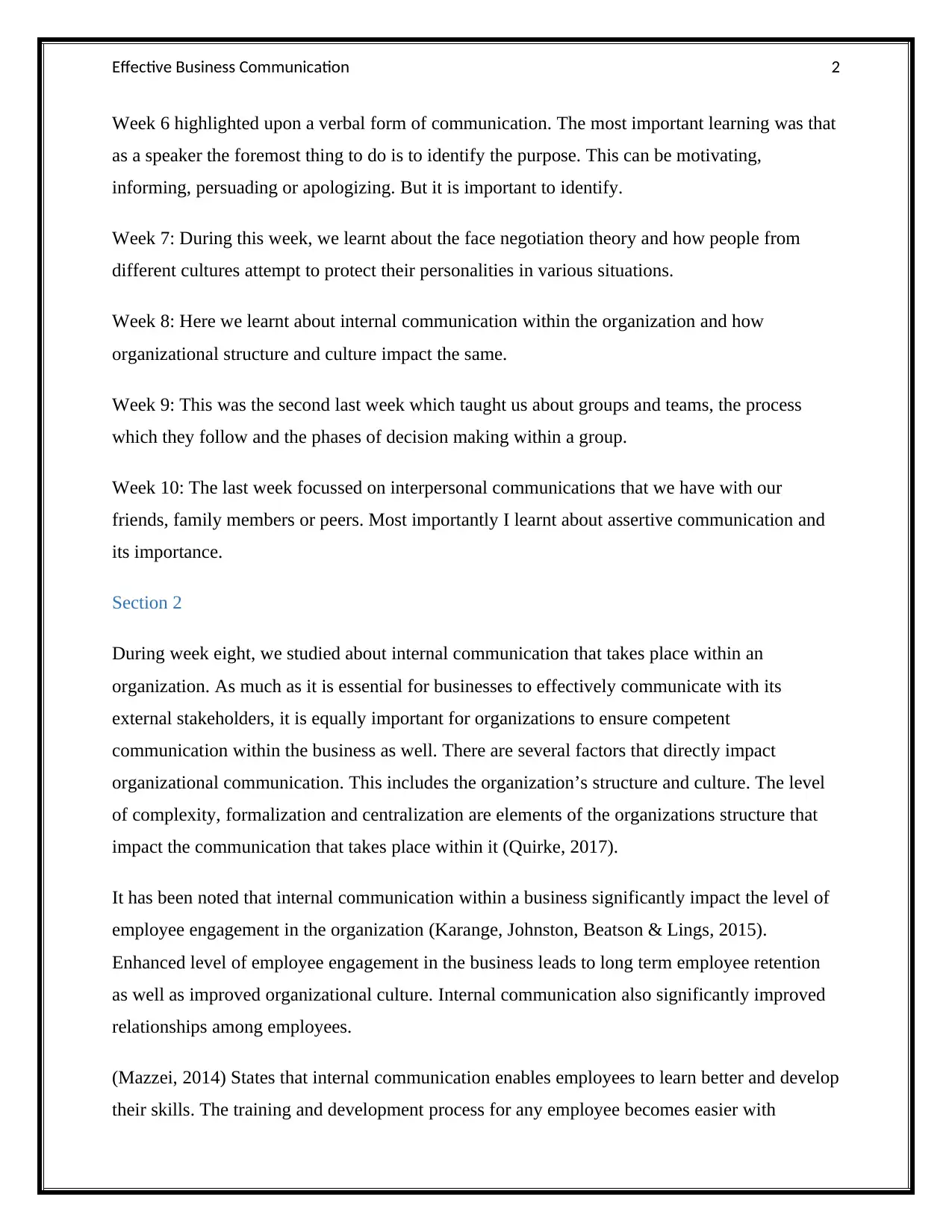
Effective Business Communication 2
Week 6 highlighted upon a verbal form of communication. The most important learning was that
as a speaker the foremost thing to do is to identify the purpose. This can be motivating,
informing, persuading or apologizing. But it is important to identify.
Week 7: During this week, we learnt about the face negotiation theory and how people from
different cultures attempt to protect their personalities in various situations.
Week 8: Here we learnt about internal communication within the organization and how
organizational structure and culture impact the same.
Week 9: This was the second last week which taught us about groups and teams, the process
which they follow and the phases of decision making within a group.
Week 10: The last week focussed on interpersonal communications that we have with our
friends, family members or peers. Most importantly I learnt about assertive communication and
its importance.
Section 2
During week eight, we studied about internal communication that takes place within an
organization. As much as it is essential for businesses to effectively communicate with its
external stakeholders, it is equally important for organizations to ensure competent
communication within the business as well. There are several factors that directly impact
organizational communication. This includes the organization’s structure and culture. The level
of complexity, formalization and centralization are elements of the organizations structure that
impact the communication that takes place within it (Quirke, 2017).
It has been noted that internal communication within a business significantly impact the level of
employee engagement in the organization (Karange, Johnston, Beatson & Lings, 2015).
Enhanced level of employee engagement in the business leads to long term employee retention
as well as improved organizational culture. Internal communication also significantly improved
relationships among employees.
(Mazzei, 2014) States that internal communication enables employees to learn better and develop
their skills. The training and development process for any employee becomes easier with
Week 6 highlighted upon a verbal form of communication. The most important learning was that
as a speaker the foremost thing to do is to identify the purpose. This can be motivating,
informing, persuading or apologizing. But it is important to identify.
Week 7: During this week, we learnt about the face negotiation theory and how people from
different cultures attempt to protect their personalities in various situations.
Week 8: Here we learnt about internal communication within the organization and how
organizational structure and culture impact the same.
Week 9: This was the second last week which taught us about groups and teams, the process
which they follow and the phases of decision making within a group.
Week 10: The last week focussed on interpersonal communications that we have with our
friends, family members or peers. Most importantly I learnt about assertive communication and
its importance.
Section 2
During week eight, we studied about internal communication that takes place within an
organization. As much as it is essential for businesses to effectively communicate with its
external stakeholders, it is equally important for organizations to ensure competent
communication within the business as well. There are several factors that directly impact
organizational communication. This includes the organization’s structure and culture. The level
of complexity, formalization and centralization are elements of the organizations structure that
impact the communication that takes place within it (Quirke, 2017).
It has been noted that internal communication within a business significantly impact the level of
employee engagement in the organization (Karange, Johnston, Beatson & Lings, 2015).
Enhanced level of employee engagement in the business leads to long term employee retention
as well as improved organizational culture. Internal communication also significantly improved
relationships among employees.
(Mazzei, 2014) States that internal communication enables employees to learn better and develop
their skills. The training and development process for any employee becomes easier with
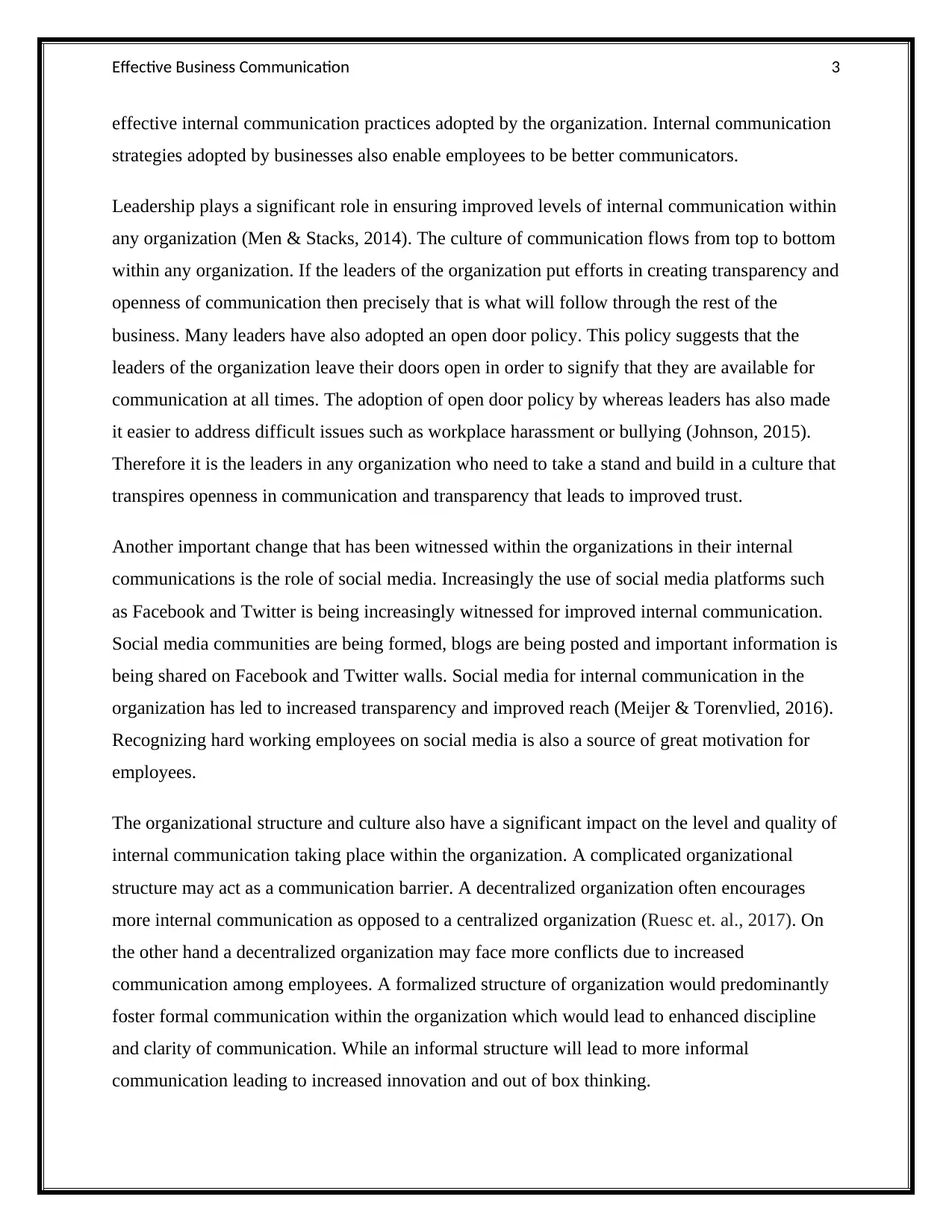
Effective Business Communication 3
effective internal communication practices adopted by the organization. Internal communication
strategies adopted by businesses also enable employees to be better communicators.
Leadership plays a significant role in ensuring improved levels of internal communication within
any organization (Men & Stacks, 2014). The culture of communication flows from top to bottom
within any organization. If the leaders of the organization put efforts in creating transparency and
openness of communication then precisely that is what will follow through the rest of the
business. Many leaders have also adopted an open door policy. This policy suggests that the
leaders of the organization leave their doors open in order to signify that they are available for
communication at all times. The adoption of open door policy by whereas leaders has also made
it easier to address difficult issues such as workplace harassment or bullying (Johnson, 2015).
Therefore it is the leaders in any organization who need to take a stand and build in a culture that
transpires openness in communication and transparency that leads to improved trust.
Another important change that has been witnessed within the organizations in their internal
communications is the role of social media. Increasingly the use of social media platforms such
as Facebook and Twitter is being increasingly witnessed for improved internal communication.
Social media communities are being formed, blogs are being posted and important information is
being shared on Facebook and Twitter walls. Social media for internal communication in the
organization has led to increased transparency and improved reach (Meijer & Torenvlied, 2016).
Recognizing hard working employees on social media is also a source of great motivation for
employees.
The organizational structure and culture also have a significant impact on the level and quality of
internal communication taking place within the organization. A complicated organizational
structure may act as a communication barrier. A decentralized organization often encourages
more internal communication as opposed to a centralized organization (Ruesc et. al., 2017). On
the other hand a decentralized organization may face more conflicts due to increased
communication among employees. A formalized structure of organization would predominantly
foster formal communication within the organization which would lead to enhanced discipline
and clarity of communication. While an informal structure will lead to more informal
communication leading to increased innovation and out of box thinking.
effective internal communication practices adopted by the organization. Internal communication
strategies adopted by businesses also enable employees to be better communicators.
Leadership plays a significant role in ensuring improved levels of internal communication within
any organization (Men & Stacks, 2014). The culture of communication flows from top to bottom
within any organization. If the leaders of the organization put efforts in creating transparency and
openness of communication then precisely that is what will follow through the rest of the
business. Many leaders have also adopted an open door policy. This policy suggests that the
leaders of the organization leave their doors open in order to signify that they are available for
communication at all times. The adoption of open door policy by whereas leaders has also made
it easier to address difficult issues such as workplace harassment or bullying (Johnson, 2015).
Therefore it is the leaders in any organization who need to take a stand and build in a culture that
transpires openness in communication and transparency that leads to improved trust.
Another important change that has been witnessed within the organizations in their internal
communications is the role of social media. Increasingly the use of social media platforms such
as Facebook and Twitter is being increasingly witnessed for improved internal communication.
Social media communities are being formed, blogs are being posted and important information is
being shared on Facebook and Twitter walls. Social media for internal communication in the
organization has led to increased transparency and improved reach (Meijer & Torenvlied, 2016).
Recognizing hard working employees on social media is also a source of great motivation for
employees.
The organizational structure and culture also have a significant impact on the level and quality of
internal communication taking place within the organization. A complicated organizational
structure may act as a communication barrier. A decentralized organization often encourages
more internal communication as opposed to a centralized organization (Ruesc et. al., 2017). On
the other hand a decentralized organization may face more conflicts due to increased
communication among employees. A formalized structure of organization would predominantly
foster formal communication within the organization which would lead to enhanced discipline
and clarity of communication. While an informal structure will lead to more informal
communication leading to increased innovation and out of box thinking.
Secure Best Marks with AI Grader
Need help grading? Try our AI Grader for instant feedback on your assignments.
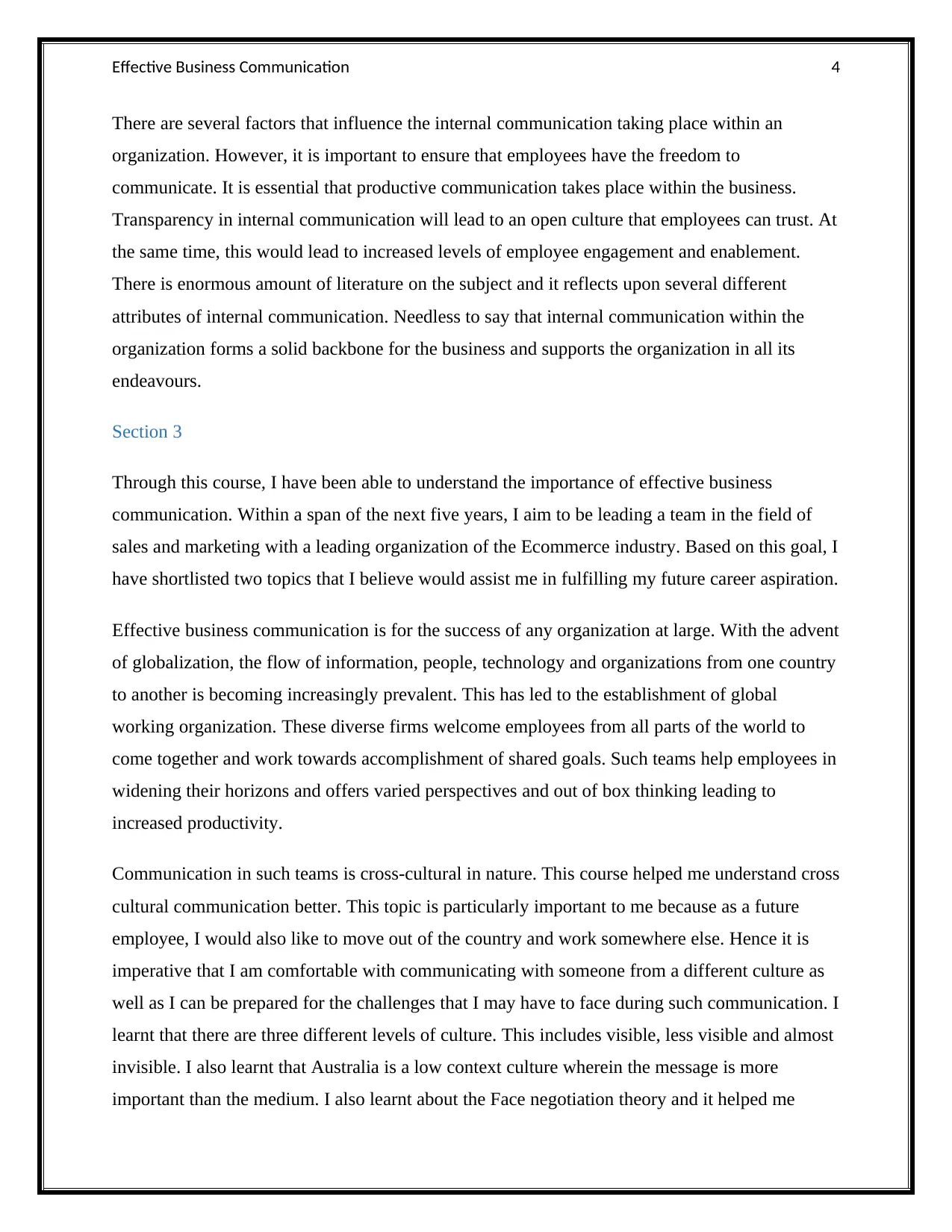
Effective Business Communication 4
There are several factors that influence the internal communication taking place within an
organization. However, it is important to ensure that employees have the freedom to
communicate. It is essential that productive communication takes place within the business.
Transparency in internal communication will lead to an open culture that employees can trust. At
the same time, this would lead to increased levels of employee engagement and enablement.
There is enormous amount of literature on the subject and it reflects upon several different
attributes of internal communication. Needless to say that internal communication within the
organization forms a solid backbone for the business and supports the organization in all its
endeavours.
Section 3
Through this course, I have been able to understand the importance of effective business
communication. Within a span of the next five years, I aim to be leading a team in the field of
sales and marketing with a leading organization of the Ecommerce industry. Based on this goal, I
have shortlisted two topics that I believe would assist me in fulfilling my future career aspiration.
Effective business communication is for the success of any organization at large. With the advent
of globalization, the flow of information, people, technology and organizations from one country
to another is becoming increasingly prevalent. This has led to the establishment of global
working organization. These diverse firms welcome employees from all parts of the world to
come together and work towards accomplishment of shared goals. Such teams help employees in
widening their horizons and offers varied perspectives and out of box thinking leading to
increased productivity.
Communication in such teams is cross-cultural in nature. This course helped me understand cross
cultural communication better. This topic is particularly important to me because as a future
employee, I would also like to move out of the country and work somewhere else. Hence it is
imperative that I am comfortable with communicating with someone from a different culture as
well as I can be prepared for the challenges that I may have to face during such communication. I
learnt that there are three different levels of culture. This includes visible, less visible and almost
invisible. I also learnt that Australia is a low context culture wherein the message is more
important than the medium. I also learnt about the Face negotiation theory and it helped me
There are several factors that influence the internal communication taking place within an
organization. However, it is important to ensure that employees have the freedom to
communicate. It is essential that productive communication takes place within the business.
Transparency in internal communication will lead to an open culture that employees can trust. At
the same time, this would lead to increased levels of employee engagement and enablement.
There is enormous amount of literature on the subject and it reflects upon several different
attributes of internal communication. Needless to say that internal communication within the
organization forms a solid backbone for the business and supports the organization in all its
endeavours.
Section 3
Through this course, I have been able to understand the importance of effective business
communication. Within a span of the next five years, I aim to be leading a team in the field of
sales and marketing with a leading organization of the Ecommerce industry. Based on this goal, I
have shortlisted two topics that I believe would assist me in fulfilling my future career aspiration.
Effective business communication is for the success of any organization at large. With the advent
of globalization, the flow of information, people, technology and organizations from one country
to another is becoming increasingly prevalent. This has led to the establishment of global
working organization. These diverse firms welcome employees from all parts of the world to
come together and work towards accomplishment of shared goals. Such teams help employees in
widening their horizons and offers varied perspectives and out of box thinking leading to
increased productivity.
Communication in such teams is cross-cultural in nature. This course helped me understand cross
cultural communication better. This topic is particularly important to me because as a future
employee, I would also like to move out of the country and work somewhere else. Hence it is
imperative that I am comfortable with communicating with someone from a different culture as
well as I can be prepared for the challenges that I may have to face during such communication. I
learnt that there are three different levels of culture. This includes visible, less visible and almost
invisible. I also learnt that Australia is a low context culture wherein the message is more
important than the medium. I also learnt about the Face negotiation theory and it helped me
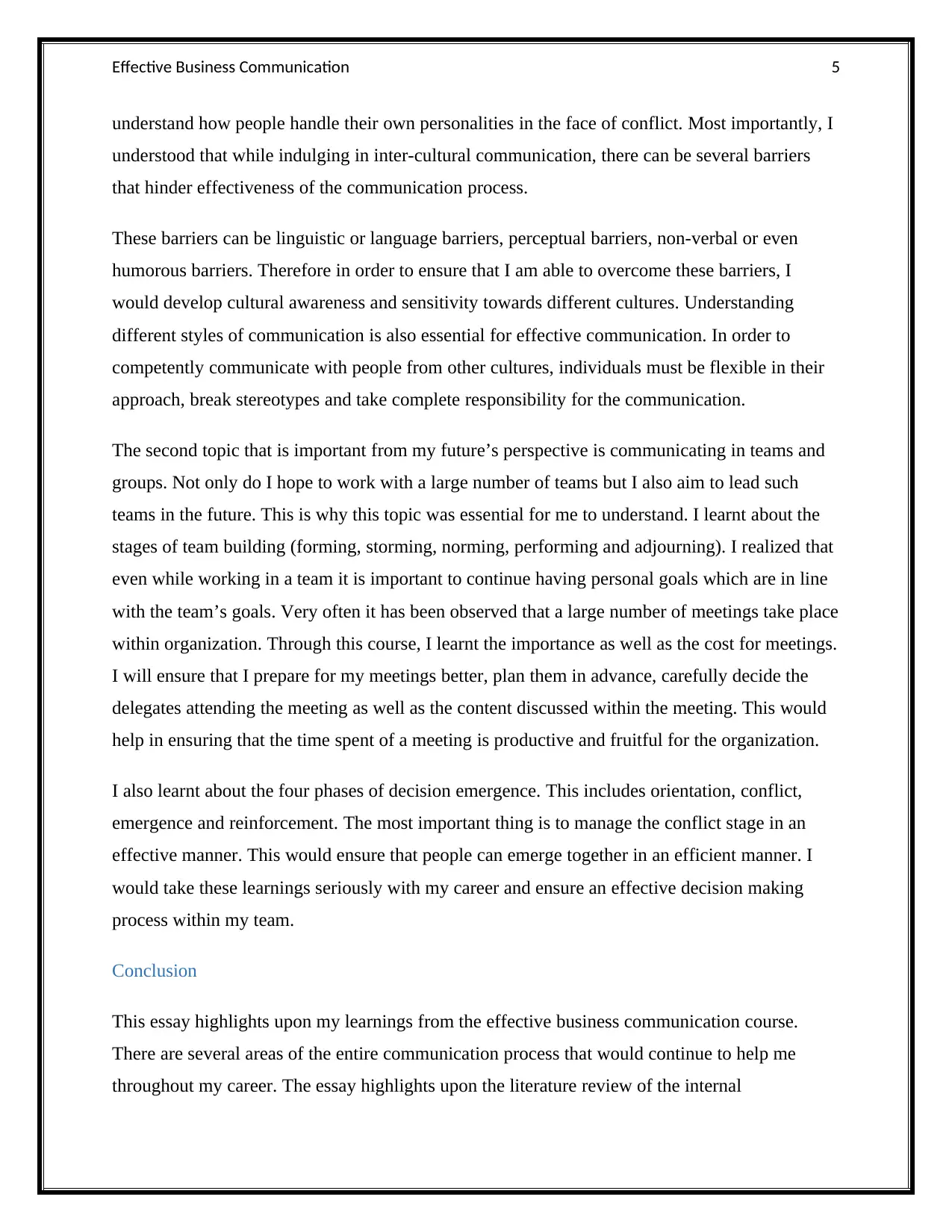
Effective Business Communication 5
understand how people handle their own personalities in the face of conflict. Most importantly, I
understood that while indulging in inter-cultural communication, there can be several barriers
that hinder effectiveness of the communication process.
These barriers can be linguistic or language barriers, perceptual barriers, non-verbal or even
humorous barriers. Therefore in order to ensure that I am able to overcome these barriers, I
would develop cultural awareness and sensitivity towards different cultures. Understanding
different styles of communication is also essential for effective communication. In order to
competently communicate with people from other cultures, individuals must be flexible in their
approach, break stereotypes and take complete responsibility for the communication.
The second topic that is important from my future’s perspective is communicating in teams and
groups. Not only do I hope to work with a large number of teams but I also aim to lead such
teams in the future. This is why this topic was essential for me to understand. I learnt about the
stages of team building (forming, storming, norming, performing and adjourning). I realized that
even while working in a team it is important to continue having personal goals which are in line
with the team’s goals. Very often it has been observed that a large number of meetings take place
within organization. Through this course, I learnt the importance as well as the cost for meetings.
I will ensure that I prepare for my meetings better, plan them in advance, carefully decide the
delegates attending the meeting as well as the content discussed within the meeting. This would
help in ensuring that the time spent of a meeting is productive and fruitful for the organization.
I also learnt about the four phases of decision emergence. This includes orientation, conflict,
emergence and reinforcement. The most important thing is to manage the conflict stage in an
effective manner. This would ensure that people can emerge together in an efficient manner. I
would take these learnings seriously with my career and ensure an effective decision making
process within my team.
Conclusion
This essay highlights upon my learnings from the effective business communication course.
There are several areas of the entire communication process that would continue to help me
throughout my career. The essay highlights upon the literature review of the internal
understand how people handle their own personalities in the face of conflict. Most importantly, I
understood that while indulging in inter-cultural communication, there can be several barriers
that hinder effectiveness of the communication process.
These barriers can be linguistic or language barriers, perceptual barriers, non-verbal or even
humorous barriers. Therefore in order to ensure that I am able to overcome these barriers, I
would develop cultural awareness and sensitivity towards different cultures. Understanding
different styles of communication is also essential for effective communication. In order to
competently communicate with people from other cultures, individuals must be flexible in their
approach, break stereotypes and take complete responsibility for the communication.
The second topic that is important from my future’s perspective is communicating in teams and
groups. Not only do I hope to work with a large number of teams but I also aim to lead such
teams in the future. This is why this topic was essential for me to understand. I learnt about the
stages of team building (forming, storming, norming, performing and adjourning). I realized that
even while working in a team it is important to continue having personal goals which are in line
with the team’s goals. Very often it has been observed that a large number of meetings take place
within organization. Through this course, I learnt the importance as well as the cost for meetings.
I will ensure that I prepare for my meetings better, plan them in advance, carefully decide the
delegates attending the meeting as well as the content discussed within the meeting. This would
help in ensuring that the time spent of a meeting is productive and fruitful for the organization.
I also learnt about the four phases of decision emergence. This includes orientation, conflict,
emergence and reinforcement. The most important thing is to manage the conflict stage in an
effective manner. This would ensure that people can emerge together in an efficient manner. I
would take these learnings seriously with my career and ensure an effective decision making
process within my team.
Conclusion
This essay highlights upon my learnings from the effective business communication course.
There are several areas of the entire communication process that would continue to help me
throughout my career. The essay highlights upon the literature review of the internal
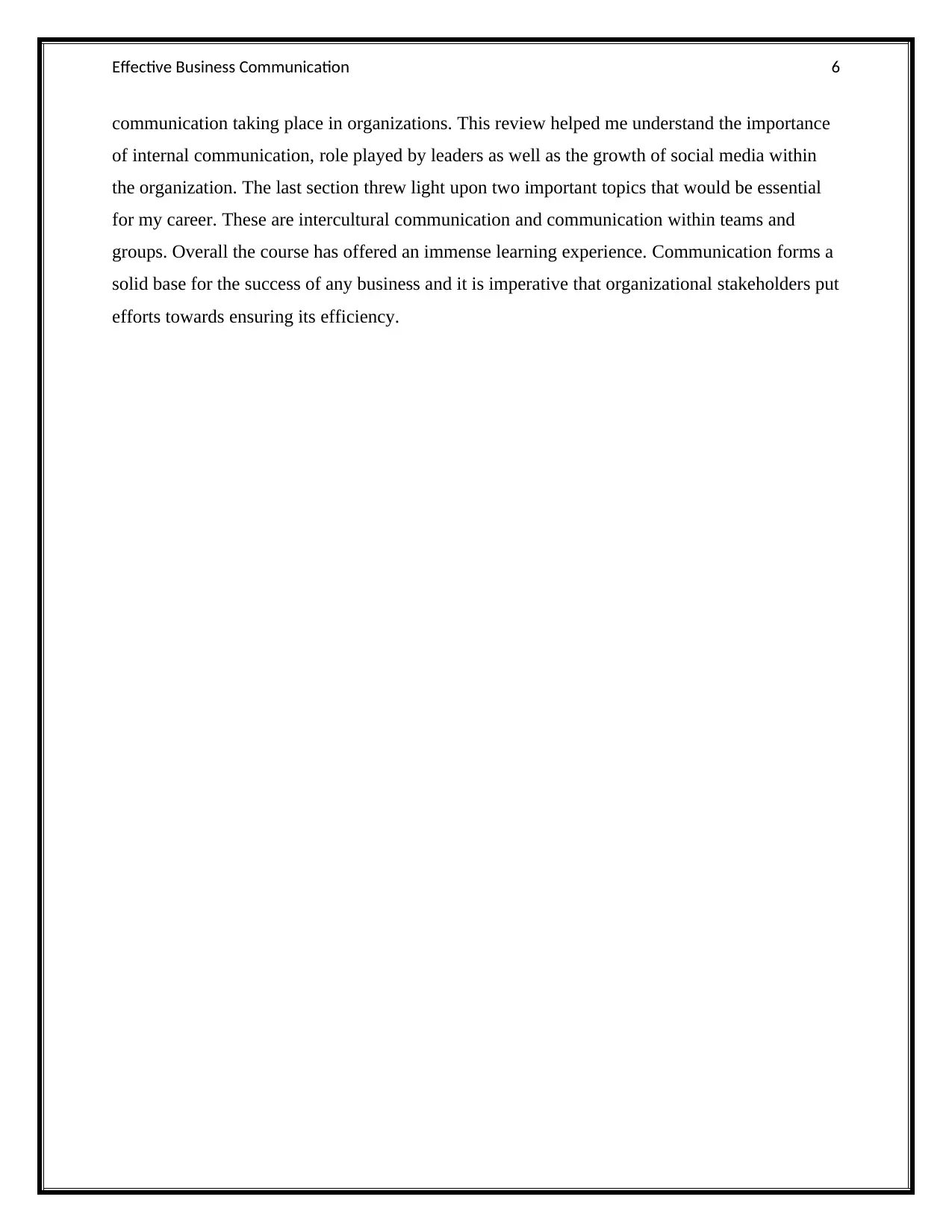
Effective Business Communication 6
communication taking place in organizations. This review helped me understand the importance
of internal communication, role played by leaders as well as the growth of social media within
the organization. The last section threw light upon two important topics that would be essential
for my career. These are intercultural communication and communication within teams and
groups. Overall the course has offered an immense learning experience. Communication forms a
solid base for the success of any business and it is imperative that organizational stakeholders put
efforts towards ensuring its efficiency.
communication taking place in organizations. This review helped me understand the importance
of internal communication, role played by leaders as well as the growth of social media within
the organization. The last section threw light upon two important topics that would be essential
for my career. These are intercultural communication and communication within teams and
groups. Overall the course has offered an immense learning experience. Communication forms a
solid base for the success of any business and it is imperative that organizational stakeholders put
efforts towards ensuring its efficiency.
Paraphrase This Document
Need a fresh take? Get an instant paraphrase of this document with our AI Paraphraser
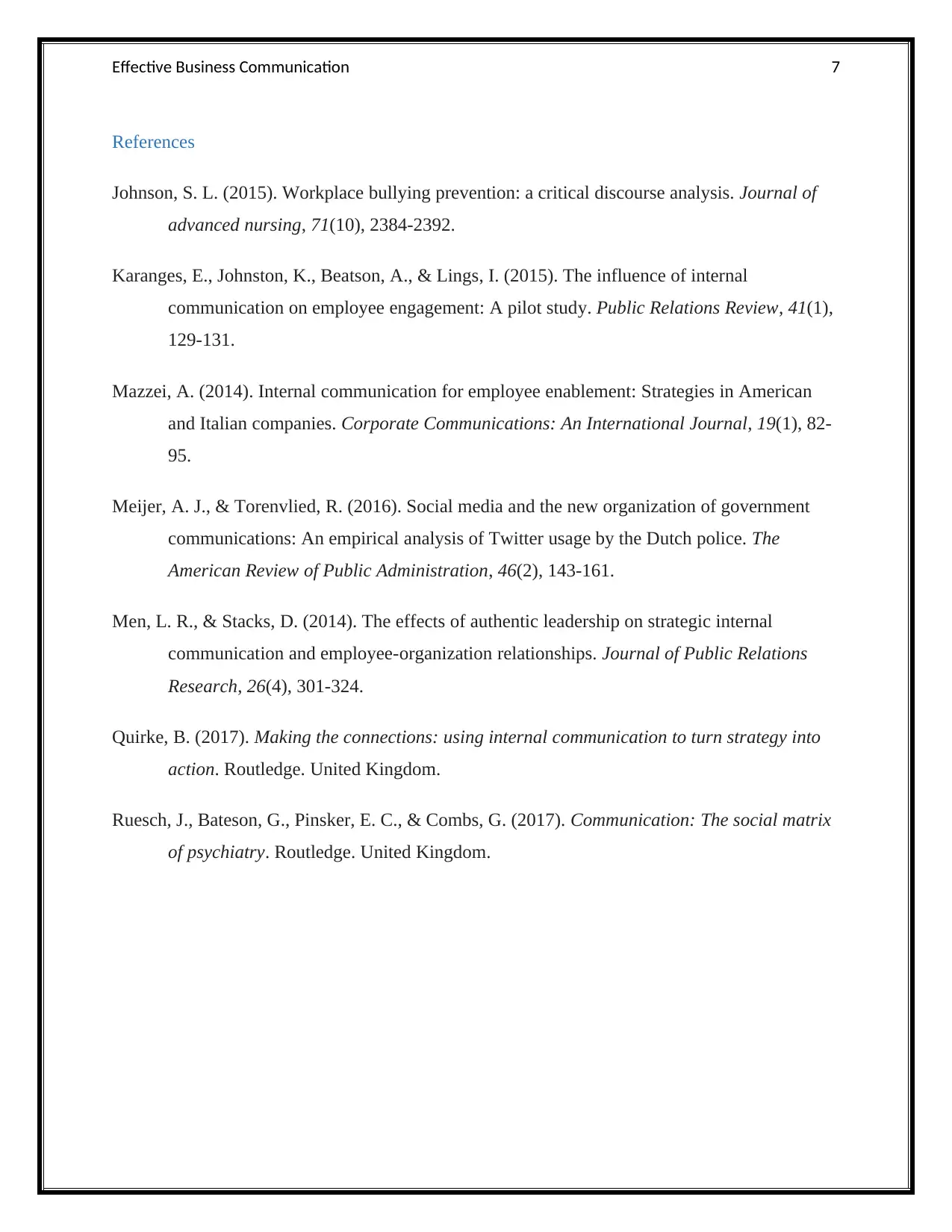
Effective Business Communication 7
References
Johnson, S. L. (2015). Workplace bullying prevention: a critical discourse analysis. Journal of
advanced nursing, 71(10), 2384-2392.
Karanges, E., Johnston, K., Beatson, A., & Lings, I. (2015). The influence of internal
communication on employee engagement: A pilot study. Public Relations Review, 41(1),
129-131.
Mazzei, A. (2014). Internal communication for employee enablement: Strategies in American
and Italian companies. Corporate Communications: An International Journal, 19(1), 82-
95.
Meijer, A. J., & Torenvlied, R. (2016). Social media and the new organization of government
communications: An empirical analysis of Twitter usage by the Dutch police. The
American Review of Public Administration, 46(2), 143-161.
Men, L. R., & Stacks, D. (2014). The effects of authentic leadership on strategic internal
communication and employee-organization relationships. Journal of Public Relations
Research, 26(4), 301-324.
Quirke, B. (2017). Making the connections: using internal communication to turn strategy into
action. Routledge. United Kingdom.
Ruesch, J., Bateson, G., Pinsker, E. C., & Combs, G. (2017). Communication: The social matrix
of psychiatry. Routledge. United Kingdom.
References
Johnson, S. L. (2015). Workplace bullying prevention: a critical discourse analysis. Journal of
advanced nursing, 71(10), 2384-2392.
Karanges, E., Johnston, K., Beatson, A., & Lings, I. (2015). The influence of internal
communication on employee engagement: A pilot study. Public Relations Review, 41(1),
129-131.
Mazzei, A. (2014). Internal communication for employee enablement: Strategies in American
and Italian companies. Corporate Communications: An International Journal, 19(1), 82-
95.
Meijer, A. J., & Torenvlied, R. (2016). Social media and the new organization of government
communications: An empirical analysis of Twitter usage by the Dutch police. The
American Review of Public Administration, 46(2), 143-161.
Men, L. R., & Stacks, D. (2014). The effects of authentic leadership on strategic internal
communication and employee-organization relationships. Journal of Public Relations
Research, 26(4), 301-324.
Quirke, B. (2017). Making the connections: using internal communication to turn strategy into
action. Routledge. United Kingdom.
Ruesch, J., Bateson, G., Pinsker, E. C., & Combs, G. (2017). Communication: The social matrix
of psychiatry. Routledge. United Kingdom.
1 out of 8
Related Documents
Your All-in-One AI-Powered Toolkit for Academic Success.
+13062052269
info@desklib.com
Available 24*7 on WhatsApp / Email
![[object Object]](/_next/static/media/star-bottom.7253800d.svg)
Unlock your academic potential
© 2024 | Zucol Services PVT LTD | All rights reserved.




